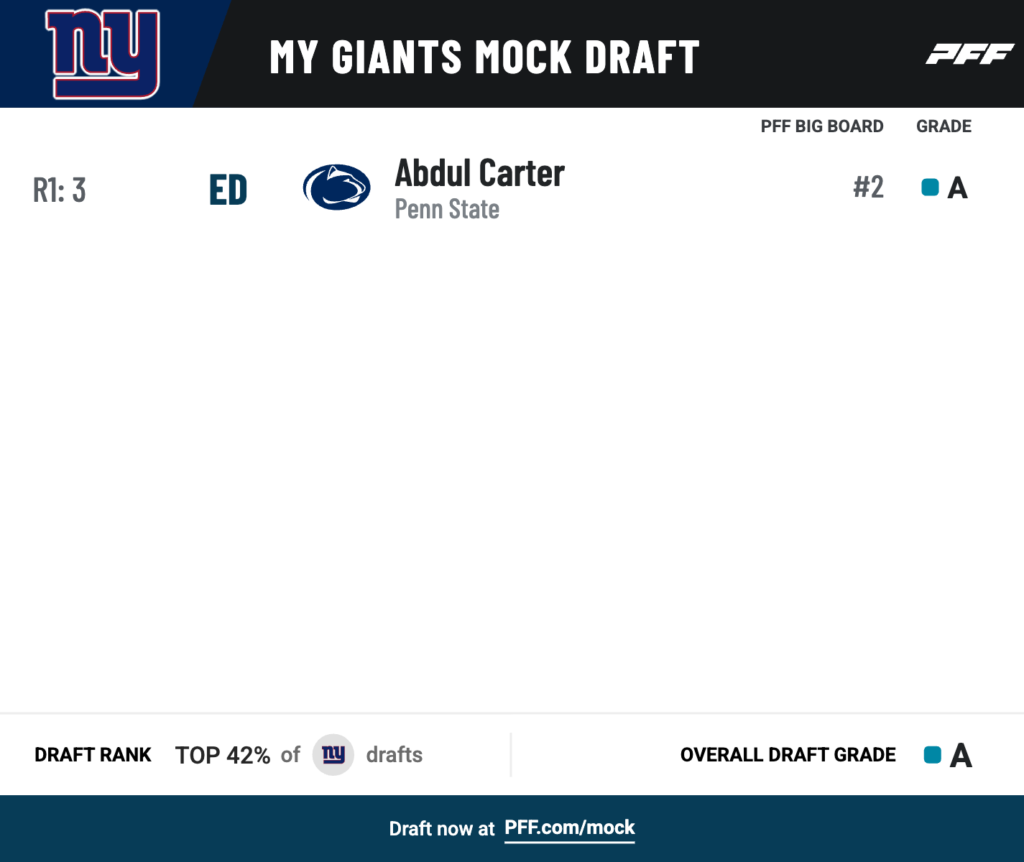
- Shedeur Sanders, Luther Burden III and Tyler Warren would thrive in a Shanahan scheme: Burden and Warren could be envisioned in Deebo Samuel and George Kittle roles, respectively, while Sanders accurately delivers the ball.
- Edge rushers Abdul Carter and Princely Umanmielen headline the classic 3-4 defense: Carter’s alignment versatility and Umanmielen’s penchant for generating pressure would wreak havoc on opposing passers.
Estimated Reading Time: 9 minutes
Click here for more draft tools:
NFL Draft Big Board | Mock Draft Simulator | NCAA Premium Stats
2025 PFF Draft Guide | Mock Draft Hub | Prospect Data Profiles
Draft Position Rankings
In a vacuum, creating an NFL draft prospect board should simply be a case of putting players in descending order of talent. That’s not the case, however, when building a team catered to a specific vision. Every front office and play caller in the NFL envisions different requirements for their players based on their system.
As we continue to hypothesize each team’s potential actions in the 2025 NFL Draft, we’ll pick out a couple of systems on each side of the ball that some of these coaches may lean toward in the selection process.
To avoid building teams loaded with first-round talent, the following rules will be put in place:
- Offensive rosters will be built in 11 personnel (1 RB, 3 WR, 1 TE)
- Three players can be selected from the top 40 of PFF’s big board
- Four players can be selected from Nos. 41-100 of PFF’s big board
- Four players can be selected from No. 101 onward of PFF’s big board

Shanahan Scheme
Notable play callers: Kyle Shanahan, Kevin O’Connell, Mike McDaniel, Klint Kubiak
Goals
- Successful outside-zone run scheme
- Explosive plays created via play action
- Maximize yards after catch
QB: Shedeur Sanders, Colorado
RB: Kaleb Johnson, Iowa
WR1: Luther Burden III, Missouri
WR2: Pat Bryant, Illinois
WR3: Andrew Armstrong, Arkansas
TE: Tyler Warren, Penn State
LT: Aireontae Ersery, Minnesota
LG: Donovan Jackson, Ohio State
C: Jonah Monheim, USC
RG: Luke Kandra, Cincinnati
RT: Armand Membou, Missouri
The idea of the Shanahan-style offense is to establish the outside-zone run game and then accurately distribute the football to explosive playmakers who excel after the catch.
Two of the top 40 selections were used on Luther Burden III and Tyler Warren, who could respectively be envisioned in Deebo Samuel and George Kittle types of roles. With Shedeur Sanders calmly and accurately delivering the football in stride, having recorded the third-highest adjusted completion rate (81.8%) in the draft class, those two would carry a large load of a potentially deadly play-action passing game.

The offensive line is headlined by two of the most physically imposing outside-zone blockers in the draft, Missouri’s Armand Membou and Minnesota’s Aireontae Ersery. Both earned an 80.0-plus PFF grade on such plays in 2024. They flank a very athletic interior unit that includes two selections outside the top 100. Cincinnati’s Luke Kandra is one of the most experienced and effective outside-zone blockers in the class and could be a realistic target for one of the Shanahan-system teams come draft weekend.
Balancing value with potential at running back was tough, given the potential late-round value of players like Bhayshul Tuten and Jaydon Blue. I opted for Kaleb Johnson, though, who may not have posted the blazing 40-yard dash time of those players but has the build of a workhorse and very good zone vision.
Modern Spread/RPO Scheme
Notable play callers: Andy Reid, Nick Sirianni, Kellen Moore, Shane Steichen
Goals
- Efficient inside-zone run scheme
- High RPO rates
- Create mismatches vs. man coverage
QB: Cam Ward, Miami (FL)
RB: RJ Harvey, UCF
WR1: Tetairoa McMillan, Arizona
WR2: Tory Horton, Colorado State
WR3: Tez Johnson, Oregon
TE: Mason Taylor, LSU
LT: Will Campbell, LSU
LG: Tyler Booker, Alabama
C: Jared Wilson, Georgia
RG: Dylan Fairchild, Georgia
RT: Ozzy Trapilo, Boston College
Simplified run schemes and advantageous single-coverage matchups allow this offense to thrive. Cam Ward commandeers this team after attempting the fourth-most RPO passes in the FBS this past season, with a solid 75.5 PFF passing grade on those attempts. As far as scheme fits are concerned, Jaxson Dart and Kyle McCord were considered, particularly with their placement outside PFF’s current top 100. Ward’s potential, though, was too great to pass up.
Ward’s top target will be Tetairoa McMillan, who owned an elite 94.8 PFF receiving grade versus single coverage over the past two seasons. He would play the “A.J. Brown role” in this offense as the primary target in one-on-one situations.
UCF’s RJ Harvey makes an appearance as a Day 2 option at running back. Since the start of 2023, no FBS running back rushed for more yards on inside-zone plays than Harvey. His 92.0 PFF rushing grade on those plays ranked second in the nation. Harvey’s vision, quickness and receiving ability would shine behind this offensive line.
Speaking of the offensive line, we have a potentially monstrous unit headlined by former SEC stars. Will Campbell and Tyler Booker would pave the way for Harvey on the left side. Georgia’s interior duo of Jared Wilson and Dylan Fairchild offer superb pass protection and plenty of inside-zone experience. Right tackle Ozzy Trapilo closes things out as the road grader on the right side.
Multiple Run/Read Option Scheme
Notable play callers: Todd Monken, Kliff Kingsbury, Greg Roman (pre-Chargers)
Goals
- Quarterback-centric offense that allows for dual-threat QB
- Multiple run schemes that include pullers, misdirection and options
- Varied passing game depending on type of passer
QB: Jalen Milroe, Alabama
RB: Ashton Jeanty, Boise State
WR1: Matthew Golden, Texas
WR2: Jack Bech, TCU
WR3: Isaiah Bond, Texas
TE: Terrance Ferguson, Oregon
LT: Josh Conerly Jr., Oregon
LG: Wyatt Milum, West Virginia
C: Seth McLaughlin, Ohio State
RG: Tate Ratledge, Georgia
RT: Ajani Cornelius, Oregon
The vision for this offense is similar to those run in the present and past by players like Lamar Jackson, Jayden Daniels and Cam Newton. Being that Jalen Milroe is the quarterback here, the offense will be built around his dynamic rushing ability and powerful arm that racked up 45 big-time throws over the past two seasons.

Joining him in the backfield is record-setting Boise State running back Ashton Jeanty. He spent the past three seasons earning a perfect 99.9 rushing grade while breaking 284 tackles as a runner. A read-option package including him and Milroe could be unstoppable behind this offensive line, particularly with excellent athletes like Tate Ratledge and Wyatt Milum manning the two guard spots.
The receiving corps is built on the blazing speed of Texas teammates Matthew Golden and Isaiah Bond. Milroe also played with Bond at Alabama, where the two formed a dangerous vertical connection. Jack Bech rounds out the group as a power slot type of player who could move the chains with his route running while also aiding the run game as a blocker.
Zone-Based 4-2-5
Notable play callers: Robert Saleh, DeMeco Ryans, Matt Eberflus, Shane Bowen
Goals
- Apply pressure with four-man rush (low blitz rate)
- High zone coverage rates (Generally Cover 3 or Cover 4)
- Penetrate interior gaps in run defense
ED: Shemar Stewart, Texas A&M
ED: JT Tuimoloau, Ohio State
DI: Mason Graham, Michigan
DI: Jamaree Caldwell, Oregon
LB: Demetrius Knight Jr., South Carolina
LB: Jack Kiser, Notre Dame
Outside CB: Jahdae Barron, Texas
Outside CB: Darien Porter, Iowa State
Slot CB: Jacob Parrish, Kansas State
S: Andrew Mukuba, Texas
S: R.J. Mickens, Clemson
Admittedly, my first instinct was to start this defense with Michigan’s Mason Graham, a potentially dominant 3-technique at the NFL level who earned an incredible 92.5 PFF grade over the past two seasons. While there were some mild chances taken, including hoping for the pass-rush development of Shemar Stewart and JT Tuimoloau, Graham’s presence inside mitigates that a bit.
At the second level, Notre Dame’s Jack Kiser and South Carolina’s Demetrius Knight Jr. complement each other well. Kiser amazingly earned at least an 80.0 PFF run-defense grade in five straight seasons. He’s a bit inconsistent in coverage, but that’s where Knight comes in. Knight has earned an elite 92.4 PFF coverage grade over the past two seasons.
Zone coverage ability is the theme in the secondary, and we have that in spades. Jahdae Barron and Darien Porter ranked first and second, respectively, among FBS cornerbacks in zone PFF coverage grade in 2024. Meanwhile, if we combine coverage PFF grade across snaps in Cover 3 and Cover 4, former Clemson teammates Andrew Mukuba and R.J. Mickens both ranked among the top three qualified Power Four safeties. Parrish rounds out the group as a solid zone player himself who can play in the slot.
Classic 3-4
Notable play callers: Vic Fangio, Teryl Austin, Jonathan Gannon
Goals
- Interior players who can hold two gaps and shed blocks
- Flexible stand-up outside linebackers
- Read-and-react off-ball linebackers who flow well laterally
- Deploy multiple coverages based on skills of cornerbacks
ED: Abdul Carter, Penn State
ED: Princely Umanmielen, Ole Miss
DI: Ty Robinson, Nebraska
DI: Jordan Phillips, Maryland
DI: Alfred Collins, Texas
LB: Jihaad Campbell, Alabama
LB: Jeffrey Bassa, Oregon
Outside CB: Benjamin Morrison, Notre Dame
Outside CB: Mello Dotson, Kansas
S: Xavier Watts, Notre Dame
S: Jonas Sanker, Virginia
The classic 3-4 defensive front isn’t as in vogue, but some teams will still use it to match with base or heavier personnel. The unit that headlines this roster is the dynamic edge pairing of Abdul Carter and Princely Umanmielen. Either or both could wreak havoc on an opposing passer at any time. Carter, specifically, could create problems with his ability to vary alignments and even drop into coverage if needed.

Jihaad Campbell and Jeffrey Bassa would aim to create a similar dynamic to what Roquan Smith and Patrick Queen used to have in Baltimore. Campbell is the captain who diagnoses and clogs run plays on the play side, while Bassa is free on the weakside to chase ball carriers and clean up the remaining mess.
With the final top 40 selection going to Notre Dame’s Xavier Watts, the idea was to build the secondary around his single-high ball-hawking abilities. He racked up the most interceptions and pass breakups in college football over the past two seasons. As such, he is flanked by two solid man-to-man cornerbacks in Notre Dame teammate Benjamin Morrison and ex-Kansas Jayhawk Mello Dotson. Virginia’s Jonas Sanker rounds out the group as the hard-hitting box safety.
This news was originally published on this post .










Be the first to leave a comment